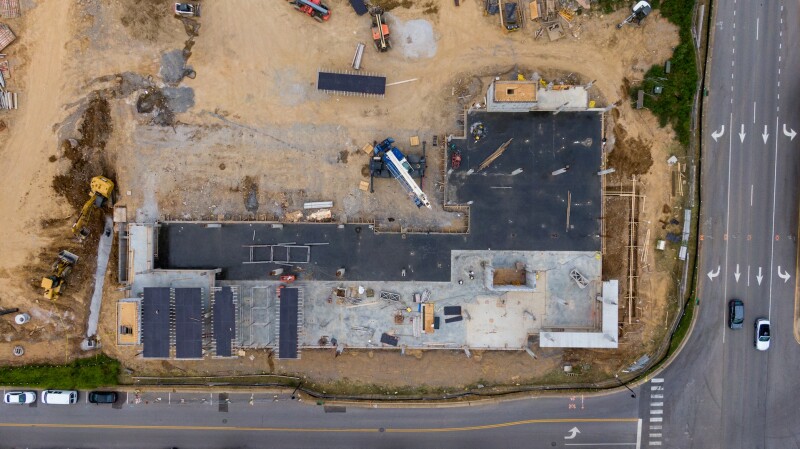According to a recent report, the adoption of drones in the construction industry has been increasing by more than 200% annually in recent years.
This growing use of uncrewed systems has enabled construction operations to take on bigger and more complex operations, such as extensive mapping projects and more frequent and more precise monitoring of job sites and assets. Sophisticated cameras and thermal imaging systems deployed on drones help construction operations detect problem areas faster and with greater accuracy. Also, tying these systems to advanced software gives construction professionals access to a wealth of information that be easily analyzed and put to use to make building projects more efficient, safer, and less expensive.
All of these advantages are driving the dramatic increase in drone adoption throughout the construction sector. Surprisingly, though, some companies have not fully integrated uncrewed processes in their work. Expensive start-up costs, difficulties in measuring true “return on investment,” gaps in resources and training, and trouble conforming to government regulations are regularly cited barriers to entry for construction firms.
To learn more about these barriers and to identify ways to overcome them, Commercial UAV News spoke with Robert McCoy, Unmanned Aerial Systems Program Manager at Crown Castle, a leading wireless infrastructure company. During our conversation, McCoy drew on his 15 years of experience in engineering, construction, mapping, and inspections management, as well as his expertise in drone technology, to explore the major impediments to uncrewed systems adoption in the construction industry.
1. Start-Up Costs
Commercial UAV News: Although drones have been shown to save construction firms time and money, getting started in UAV operations requires significant investments in new equipment—and those costs might be preventing some companies from adopting the technology. What can be done to reduce start-up costs or convince industry leaders that the initial investment is worthwhile?
McCoy: Education and awareness of drones from a top down and bottom-up approach is a good way to start. Clearly defining use cases and how drones will benefit your company is critical for future change management. Once there is buy-in, then there are a few things that can help with integration of drones. Rolling out the program by region or customer can help stagger the investment while also showing the advantages that drones bring to that sector of your business. You may overcome some resistance from leadership by performing use cases around the goals and objectives that they agree would help cut cost. Drones don’t fix all problems of most companies, but they will fill data gaps that exist in most every industry, so focus on those and show the plan to scale around them.
2. Determining ROI
Commercial UAV News: Demonstrating strong Return on Investment (ROI) goes a long way in convincing company leaders to adopt uncrewed technology in their operations. However, accurately measuring the ROI of drone operations isn’t always easy. How can drone technology advocates more effectively communicate the ways drones impact cost, time, safety, workflow, and communication?
McCoy: Often the technology around UAS is filling a gap that the company does not have great metrics on. These gaps are the most valuable to address although the company may struggle to quantify the existing problem. Collaboration and awareness across the organization are critical to make sure you bring everyone along on the digital journey. Be open to scrutiny and thoroughly test your assumptions against your agreed upon value cases in order to allow others to give their input to your eventual solution. This encourages support from others and also helps you build the next steps on items that have been accepted by your organization.
3. Lack of Resources
Commercial UAV News: Some construction firms do not have the expertise or resources to plan operations that can take full advantage of UAV technology. How can companies close the gaps and craft better mission plans in order to use uncrewed technologies to improve construction operations?
McCoy: There are hundreds of drone companies promising things that their technology can’t fully deliver. If you are limited on expertise of resources, then require proof from your potential vendors or contractors that their promises specifically meet the needs of your company. Most quality companies are willing to work with you for free or at a reduced cost in order to secure the sale. This allows your company to see the reality of the technology without massive investment upfront.
4. Regulations
Commercial UAV News: Federal, state, and local authorities have instituted regulations around the use of drones designed to ensure safety and bring order to the airways. However, many in the drone industry have cited regulations as an impediment to full adoption of the technology. How do regulations concerning BVLOS and other issues impact the construction industry? What policy changes need to take place to better integrate drones in construction operations?
McCoy: For my industry, specific to construction, the current regulatory environment is quite good. We are unique though, with very tall, slender structures the part 107 regulations are mostly sufficient. Wireless is more than towers though. Small Cell and Fiber are in more densely populated areas that could benefit from BVLOS. BVLOS will be a win for all, particularly when enabled by the wireless infrastructure. Regulators must be open to more test beds with specific goals to show what is needed to move beyond 107.
5. Cultural Barriers
Commercial UAV News: Many in the construction field, as well as other industries, have reported that it can be challenging to educate company leaders and clients that uncrewed operations can offer improvements over “tried and true” ways of doing their work. How can UAV advocates better educate reluctant clients and business leaders? How can workplace cultures be changed in order to embrace new ways of tackling construction projects?
McCoy: If your industry can fully implement building information modeling programs, then walking your clients through the details of that process is a great form of education that will help the acceptance of drone-based data. Showing that you can get more accurate, more complete data and keep it more real-time while not missing any information they currently need is key to building momentum. Change is hard in construction, just like many other industries. People resist change often. Finding drone champions at all levels of a business to influence their peers is important to help change the culture of an existing company. Do not oversell, though. This is a sure way to set your program back.
6. Training
Commercial UAV News: Getting a UAV-based construction operation up and running requires more than just purchasing a few drones and some software. New staff must be hired and/or existing personnel must be trained on the new equipment. How much of a challenge is it to hire and train new employees to take on drone-related tasks? What can be done to improve the hiring and training processes around new technology?
McCoy: I have found that in larger organizations, there are always a few willing participants to do the drone work. Processing the data and integration into and modification of existing workflows is much more difficult. One approach is to allow existing employees to augment what they do day-to-day so that the transition is gradual and allows a group to ease through into digital transformation. Another way, if your company works well with consultants, it to hire a consulting firm after you have establish clear and measurable goals to work through the transition. This approach helps avoid the feeling of overworking your employees. In most cases, there is a transition period from the old way to the new that increases the stress on a company, prior to making things much smoother. Once over the hump, you may wonder how you functioned before all the great data from drones, but in that transition it can be a very heavy burden.
Please check out our articles on barriers to drone adoption in infrastructure & transportation, surveying & mapping, and energy & utilities. Also, watch for more articles in our “6 Barriers to Drone Adoption” series in the weeks to come.















Comments